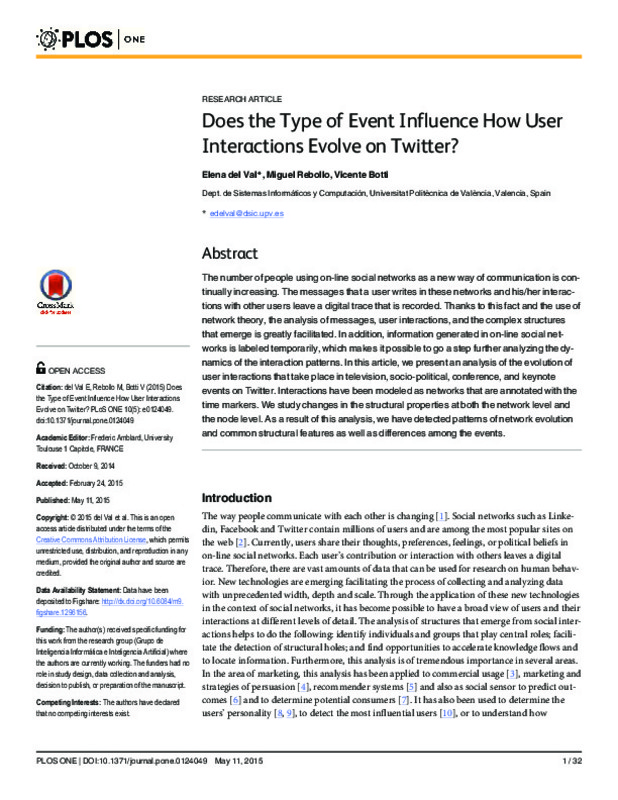Licoppe, C., & Smoreda, Z. (2005). Are social networks technologically embedded? Social Networks, 27(4), 317-335. doi:10.1016/j.socnet.2004.11.001
European Commission. JRC Scientific and Policy Report EUR 25295 EN ‘Pan-European Survey of Practices, Attitudes and Policy Preferences as regards Personal Identity Data Management’; 2012. http://is.jrc.ec.europa.eu/pages/TFS/documents/EIDSURVEY_Web_001.pdf Last access: 27-01-2015.
Jansen, B. J., Zhang, M., Sobel, K., & Chowdury, A. (2009). Twitter power: Tweets as electronic word of mouth. Journal of the American Society for Information Science and Technology, 60(11), 2169-2188. doi:10.1002/asi.21149
[+]
Licoppe, C., & Smoreda, Z. (2005). Are social networks technologically embedded? Social Networks, 27(4), 317-335. doi:10.1016/j.socnet.2004.11.001
European Commission. JRC Scientific and Policy Report EUR 25295 EN ‘Pan-European Survey of Practices, Attitudes and Policy Preferences as regards Personal Identity Data Management’; 2012. http://is.jrc.ec.europa.eu/pages/TFS/documents/EIDSURVEY_Web_001.pdf Last access: 27-01-2015.
Jansen, B. J., Zhang, M., Sobel, K., & Chowdury, A. (2009). Twitter power: Tweets as electronic word of mouth. Journal of the American Society for Information Science and Technology, 60(11), 2169-2188. doi:10.1002/asi.21149
Leskovec, J., Adamic, L. A., & Huberman, B. A. (2007). The dynamics of viral marketing. ACM Transactions on the Web, 1(1), 5-es. doi:10.1145/1232722.1232727
Guimerà, R., Llorente, A., Moro, E., & Sales-Pardo, M. (2012). Predicting Human Preferences Using the Block Structure of Complex Social Networks. PLoS ONE, 7(9), e44620. doi:10.1371/journal.pone.0044620
Borondo J, Morales AJ, Losada JC, Benito RM. Characterizing and modeling an electoral campaign in the context of Twitter: 2011 Spanish Presidential Election as a case study.; 2013.
Ahn YY, Han S, Kwak H, Moon S, Jeong H. Analysis of Topological Characteristics of Huge Online Social Networking Services. In: Proceedings of the 16th International Conference on World Wide Web. WWW ‘07. New York, NY, USA: ACM; 2007. p. 835–844.
Romero DM, Galuba W, Asur S, Huberman BA. Influence and Passivity in Social Media. In: Proceedings of the 20th International Conference Companion on World Wide Web. WWW ‘11. New York, NY, USA: ACM; 2011. p. 113–114.
Romero DM, Meeder B, Kleinberg J. Differences in the Mechanics of Information Diffusion Across Topics: Idioms, Political Hashtags, and Complex Contagion on Twitter. In: Proceedings of the 20th International Conference on World Wide Web. WWW ‘11. New York, NY, USA: ACM; 2011. p. 695–704.
Bastiaensens, S., Vandebosch, H., Poels, K., Van Cleemput, K., DeSmet, A., & De Bourdeaudhuij, I. (2014). Cyberbullying on social network sites. An experimental study into bystanders’ behavioural intentions to help the victim or reinforce the bully. Computers in Human Behavior, 31, 259-271. doi:10.1016/j.chb.2013.10.036
Google. Google Co-op; 2014. [Access 5-Jan-2014]. http://www.google.com/coop/
Wasserman, S., & Faust, K. (1994). Social Network Analysis. doi:10.1017/cbo9780511815478
Kossinets, G. (2006). Empirical Analysis of an Evolving Social Network. Science, 311(5757), 88-90. doi:10.1126/science.1116869
Scott, J. (2010). Social network analysis: developments, advances, and prospects. Social Network Analysis and Mining, 1(1), 21-26. doi:10.1007/s13278-010-0012-6
Newman, M. (2010). Networks. doi:10.1093/acprof:oso/9780199206650.001.0001
Huberman BA, Romero DM, Wu F. Social networks that matter: Twitter under the microscope. arXiv preprint arXiv:08121045. 2008;.
Mislove A, Marcon M, Gummadi KP, Druschel P, Bhattacharjee B. Measurement and Analysis of Online Social Networks. In: Proceedings of the 7th ACM SIGCOMM Conference on Internet Measurement. IMC ‘07. New York, NY, USA: ACM; 2007. p. 29–42.
Borge-Holthoefer, J., Rivero, A., García, I., Cauhé, E., Ferrer, A., Ferrer, D., … Moreno, Y. (2011). Structural and Dynamical Patterns on Online Social Networks: The Spanish May 15th Movement as a Case Study. PLoS ONE, 6(8), e23883. doi:10.1371/journal.pone.0023883
na López IP, Congosto M, Aragón P. Spanish Indignados and the evolution of 15M: towards networked para-institutions. Big Data: Challenges and Opportunities. 2013;p. 359–386.
Cha M, Haddadi H, Benevenuto F, Gummadi KP. Measuring user influence in Twitter: The million follower fallacy. In: in ICWSM ‘10: Proceedings of international AAAI Conference on Weblogs and Social; 2010.
Shamma DA, Kennedy L, Churchill EF. Tweet the Debates: Understanding Community Annotation of Uncollected Sources. In: Proceedings of the First SIGMM Workshop on Social Media. WSM ‘09. New York, NY, USA: ACM; 2009. p. 3–10. Available from: http://doi.acm.org/10.1145/1631144.1631148
Diakopoulos NA, Shamma DA. Characterizing Debate Performance via Aggregated Twitter Sentiment. In: Proceedings of the SIGCHI Conference on Human Factors in Computing Systems. CHI ‘10. ACM; 2010. p. 1195–1198.
[-]









